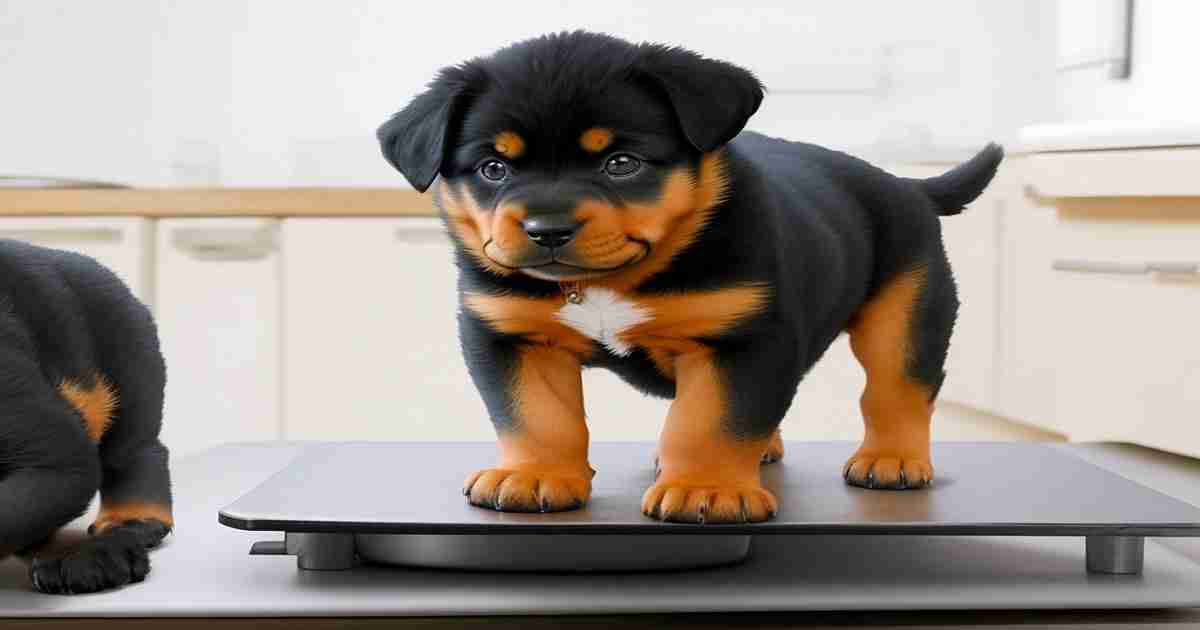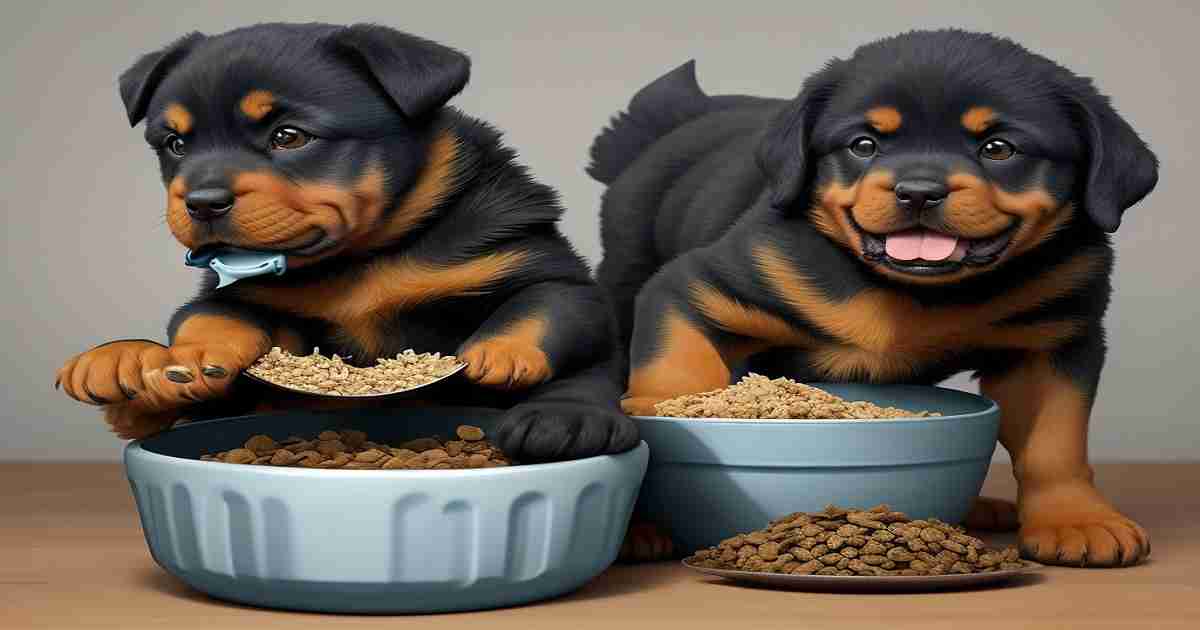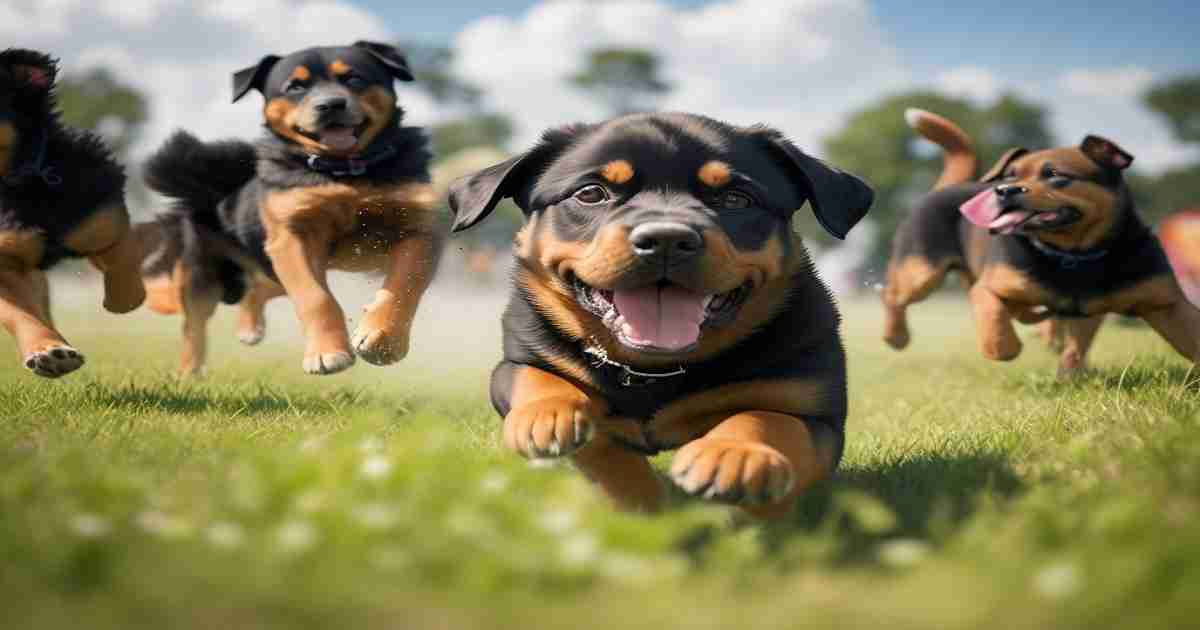Mention “Rottweiler” and most people imagine a big, burly dog with a sleek black coat and rust markings. But do you know what is rottweiler average weight? Or how quickly do Rottweiler puppies grow?
Understanding typical Rottweiler growth patterns helps ensure your pup stays happy and healthy at every stage. Whether you’re raising a petite female or a bulky male, this complete guide will cover:
- Growth rate and weight charts from puppy to rottweiler adult weight
- Ideal weight ranges
- Factors affecting size
- Care tips for your growing Rottie
- And much more!
Monitoring your Rottweiler’s development, providing proper nutrition and exercise, and noting any issues along the way give your dog their best shot at becoming a fit, well-mannered companion for years to come. So let’s dive into the averages and standards, and discover what makes these magnificent pups tick!
An Introduction to the Rottweiler Breed
Before weighing in on size stats, it helps to understand where Rottweilers come from and what they’re all about.
These large working breeds hail from Germany, where they herded cattle and pulled carts for butchers. Their name derives from the town of Rottweil, where this essential “butcher’s dog” work occurred.
Some key facts about Rottweilers:
- Originated as Roman drover dogs before settling in German towns
- Nearly went extinct in the 19th century until revived by police interest
- Recognized by the AKC in 1931 and consistently popular since
- Known for intelligence, loyalty, confidence, and protective instincts
With proper training and care, Rottweilers become devoted companions – though their wariness of strangers requires socialization. Their athleticism makes them excellent service dogs, police dogs, and competitors in various dog sports.
But when it comes to size, there’s significant variety even within this purebred breed! Let’s explore why Rottweilers come in different shapes and sizes.
What Determines Rottweiler Size And Weight?
Think all Rottweilers weigh 100+ pounds? Think again! While genetics set general parameters, several factors influence an individual dog’s ultimate size and growth pattern, including diet, exercise, and overall health.
A Rottweiler puppy fed a nutritious diet and given plenty of exercise is likely to reach its full potential size, while a puppy who is malnourished or inactive may grow more slowly or be smaller than average.
Rottweiler Growth Chart: Understanding how Rottweilers grow can help you ensure your furry friend is getting the right nutrition and exercise to reach their full potential.
Rottweiler growth charts can provide insights into average weight and height expectations for puppies at different stages of development. Remember, however, that these are just averages, and individual dogs may vary.
It’s in Their Blood (Genetics and Bloodlines)
Like humans, dogs inherit genes from their parents that affect size. Some Rottweiler bloodlines produce larger, more solid dogs versus leaner working types.
American and Canadian Rottweilers tend to be bulkier, averaging rottweiler male weight 110-135 pounds and female rottweiler weight 90-115. European dogs from German working lines have a more athletic build and moderate frame of 80-105 pounds for males and 70-90 pounds for females.
But even within the same litter, puppies may have different growth patterns. Genetics merely set the stage!
Battle of the Sexes
Due to hormonal differences and physiology, male and female Rottweilers grow differently:
- Males: tend to be more massive and muscular, reaching their full adult size around age 2 and weighing anywhere from 95-135 pounds depending on bloodlines.
- Females: have more refined, petite frames, finishing growth by 22 months and weighing 80-100 pounds on average.
On the higher end, some oversized American lines produce 150+ pound males and 100+ pound females. But the majority fall within the weight ranges above.
Diet and Exercise Influence Weight Too
While genetics determine the basic parameters, diet and activity levels make a big impact too.
Puppies and adults fed a nutritious, portion-controlled diet avoid rapid weight gain. Meanwhile, overfeeding leads to obesity. Regular exercise helps build lean muscle rather than fat.
The ideal combo? High protein food at proper calorie levels plus 60+ minutes of vigorous daily activity like running, swimming, hiking, or playing fetch. Monitor treats too!
With the right lifestyle choices, Rottweilers can stay fit and reach a healthy weight for their genetic potential.
Health Conditions Cause Abnormal Growth
Sometimes health issues affect weight and growth indirectly. For example:
- Hypothyroidism slows metabolism and causes unexplained weight gain
- Orthopedic problems like hip dysplasia reduce activity due to pain
- Parasites or diseases lead to poor nutrient absorption
See your vet if your puppy isn’t gaining as expected or your adult dog experiences weight changes. Treating any underlying medical conditions can get their growth back on track.
Ok, now that we’ve covered the factors influencing size, let’s look at actual Rottweiler weight charts and growth rate numbers!
Rottweiler Height And Weight Charts: Growth Rate and Milestones
Since they grow rapidly, especially between 3-18 months, it’s useful to track Rottweiler puppies against standard growth charts. It helps identify any issues early. Let’s explore average rottweiler weight by age and differences between male and female growth patterns.
Starting Small: Rottweiler Puppy Weight Milestones
During the first year, Rottweiler puppies transition from tiny newborns to mini versions of the large adults they will become. Here are the usual weight milestones:
- 8 weeks old: 15-20 pounds
- 3 months old: 25-35 pounds
- 6 months old: 50-70 pounds
- 9 months old: 70-90 pounds
- 12 months old: 80-110 pounds
The most rapid growth occurs between 3-9 months when pups gain around 10 pounds per month on average! Their growth plates close between 12-18 months, slowing things down.
Males vs. Females: Size and Growth Rate
Due to gender differences, male Rottweilers weigh more than females at every life stage:
| Age | Male Weight | Female Weight |
| 3 months | 27-37 pounds | 22-32 pounds |
| 6 months | 54-76 pounds | 44-66 pounds |
| 9 months | 77-97 pounds | 63-87 pounds |
| 12 months | 90-120 pounds | 70-100 pounds |
| 18 months | 100-130 pounds | 80-115 pounds |
| 24 months | 105-135 pounds | 80-120 pounds |
These charts provide a general guideline, but individual dogs may be smaller or larger. What matters most is steady age-appropriate growth, not fixating on numbers.
From Puppy to Adult: Stages of Growth and Maturity
Rottweilers go through developmental stages as they mature both physically and mentally:
The Average Weight of A Rottweiler (8 Weeks-weight 8.8-11.0 lb )
In the 2-month stage, your Rottie should be getting to know to socialize with others. He has to apprehend that he’s a dog and ought to research plenty from his mom.
Your pup will watch how their mother interacts with different dogs, with human beings, and in precise situations.
He will decide what his mother finds frightening, what she reveals exciting, and even how she eats, beverages, and plays different movements. He will take most of that training through life with him.
At the age of 8 weeks, it’s fair to take a puppy far away from his mother. At this factor, you need to take over the position of his mom and his instructor.
Introduce him to new human beings and new animals. Show him that new environment, environments, and conditions are not anything to be scared of, and try to try this often.
The Average Weight For A Rottweiler Puppy (3 Months-17 kg)
Using three months, human socialization ought to be well underway. Your doggy will start to pile at the pounds and develop taller, and you can in addition his social improvement by enrolling your dog in doggy lessons.
Pup training is now not the handiest to enable your canine to satisfy new humans and socialize with other dogs, in addition, they educate you and your dog on the fundamentals of schooling.
You will research some simple instructions, your canine might be taught a way to behave in positive instances, and you may have a pleasant surrounding wherein your canine is authorized to meet new people and new dogs and react for that reason.
Most of the conditions and responses that your canine reports through this time will shape how he reacts inside destiny.
Therefore, try and avoid very scary situations. If your dog has a bad revel with something, for instance, he receives scared through a vehicle, take matters slowly and attempt to desensitize him to the situation.
The Average Weight of Rottweiler Puppy (4 Months-23 kg)
Anticipate your doggy to test obstacles using this level. He will need to decide who is the percent leader, and he’s going to take a look at what he can get away with, just like a young child.
On the subject of education, you should stick with the regulations and to the boundaries which you have set out. At this factor, if you waver, your doggy will take gain and try and take pride.
The Average Weight of Rottweiler Puppy (6 Months-31 kg)
By using 6 months, you have to be on foot with your canine outside frequently. Introduce him to new experiences continuously.
In addition to assembling new people, make certain that he has met new forms of human beings, one-of-a-kind forms of animals, and that he is used to being walked at night time and at some point of the day.
Ensure that he is used to seeing people stroll past the home windows at home and look for approaches to beautify and boom his out-of-doors workout. Keep in mind going to agility classes or enrolling him in some other form of canine sports magnificence.
Your canine will advantage, and you will bond even more with your domestic dog. Through 6 months, your Rottie may be around two-thirds of his grownup length, however, he’ll nevertheless keep his doggy attributes and playfulness.
The Average Weight of Rottweiler Puppy (9 Months-46 KG)
A nine-month-vintage Rottweiler is similar in development to a teenage human. Even though most small breeds can be grown by the time they reach this age, the Rottweiler has a minimum of 3 more months of growth left in him.
Your Rottie can have all of his enamel, might be sexually matured, and could be losing a considerable amount of fur to your fixtures, your garments, and pretty lots anywhere. Even though he can also show a little playfulness, your Rottweiler needs to be starting to chill out a bit by this degree.
The Average Weight of Rottweilers Puppy (12 Months-50 KG)
A Rottweiler will reach full height by the point he’s three hundred and sixty-five days old, however, he’s going to in reality retain feature weight.
He can probably maintain setting weight on till he’s 3 years old due to his giant muscle as well as the sheer length of his head and different functions.
Your domestic dog will look greater like an adult, however, he still can trade his physical look in addition to his size over the subsequent 2 years.
- 0-3 weeks: Rapid early development, eyes and ears open
- 3-12 weeks: Quick puppy growth, house training begins
- 3-6 months: Most accelerated growth phase, gain up to 10 lbs weekly
- 6-18 months: Continued steady weight gain, adult height reached
- 1.5-3 years: Fill out muscle mass, mental maturity, growth plates close
With the right care and nutrition, Rottweilers transition smoothly through each stage, hitting milestones as expected. Next, let’s look at the ideal size based on breed standards.
Standard vs. Oversized: What’s Considered “Normal?”
According to the American Kennel Club breed standard, the acceptable weight for a full-grown Rottweiler is:
- Males: 95-135 pounds (88-110 pounds per the AKC standard)
- Females: 80-115 pounds (77-99 pounds per AKC)
So while the AKC sets a narrower “standard” weight, most reputable breeders strive for a slightly heavier dog with more bone substance and muscle.
Anything over 135 pounds for males and 115 pounds for rottweiler females weight would be considered oversized or giant. But as long as weight is proportionate to height, larger Rottweilers can still be healthy and structurally sound.
The keys are keeping your pup fit and active while limiting rapid weight gain. Monitoring growth along the way helps ensure they stay on track! Now that we’ve covered the numbers, let’s discuss how to care for your growing puppy or adult Rottweiler.
Caring for Your Rottweiler During Each Growth Stage
While weights and growth charts provide guidelines, raising a healthy, well-mannered Rottweiler involves so much more.
From nutrition to training to healthcare, proper care during each rottweiler life stage gives your pup the best shot at becoming your ideal companion for years to come.
Puppy Nutrition: Feeding for Proper Growth
The right diet fuels your Rottweiler puppy’s rapid development. Consider these feeding tips:
- Feed a premium puppy food with 25-30% protein minimum
- Follow package guidelines for calories based on target weight
- Split meals into 3-4 portions to prevent gorging
- Supplement with joint-supporting vitamins and minerals
- Always provide access to fresh, clean water
Switch to adult food around 12 months old. As growth slows, reduce meals to twice daily.
Keeping Your Rottie Active and Fit
Sufficient exercise prevents excess weight gain while supporting bone and joint health:
- Puppies under 3 months: Several 10-15 minute play and training sessions
- 3-6 months: Increase to 30-45 minute walks or play sessions 1-2 times per day
- 6-12 months: Ramp up to about 1 hour of exercise daily
- Adults: Aim for at least 60 minutes of vigorous activity like running, swimming, hiking
Avoid excessive exercise during growth spurts to prevent injury. And scale activity down for seniors.
Training and Socializing For a Well-Rounded Companion
Beyond physical needs, Rottweilers require extensive socialization and training:
- Start basic obedience early using positive reinforcement
- Socialize consistently – introduce new people, animals, places, and sounds
- Consider professional training for behavioral issues
- Provide mental stimulation with puzzles, Kongs, training games
- Practice commands and behaviors daily to reinforce
- Attend puppy play groups or daycare for additional social opportunities
With proper guidance and care from puppyhood through adulthood, Rottweilers develop into perfectly behaved family companions and guardians.
Vet Visits Are Essential!
See your vet for wellness checkups at least annually. Vaccinations, preventatives, and screening tests safeguard your dog’s health.
Discuss any concerns about growth or weight with your veterinarian, and report symptoms like limping, lethargy, or appetite changes promptly. Addressing problems early makes a huge difference!
With the right balance of nutrition, training, socialization, exercise, and veterinary care, your Rottweiler will thrive through every life stage.
Frequently Asked Questions About Rottweiler Growth Patterns
Let’s recap key information about rottweiler ideal weight and growth with some common FAQs:
What’s the average weight for a Rottweiler puppy?
- Rottweiler puppies gain around 10 pounds per month, reaching 25-35 pounds at 3 months old, 50-70 pounds at 6 months old, and 80-110 pounds at 1 year old.
How much should a full-grown male Rottweiler weigh?
- The average adult male Rottweiler weighs 105-135 pounds depending on breeding. The AKC standard is 110 pounds. Some oversized males reach 150 pounds.
What’s the average adult weight for a female Rottweiler?
- Females are smaller, weighing 80-100 pounds on average according to the AKC standard. Some large female lines range from 100-115 pounds.
How can I tell if my Rottweiler is overweight or underweight?
- Compare your dog’s body condition to the ideal. You should be able to faintly feel ribs under minimal fat and see a tucked waist from above. Adjust food or activity if needed.
How much should my Rottweiler puppy weigh at 6 months?
- Most Rottweiler puppies weigh between 50-70 pounds at 6 months old, gaining around 10 pounds weekly, but focus less on exact numbers and more on steady progression.
When do Rottweilers stop growing?
- Rottweilers reach full adult size between 18-24 months old once their growth plates close. They finish filling out muscle mass by 2-3 years old. And there you have it – a complete overview of common Rottweiler growth patterns and weight milestones!
- How much does a rottweiler weigh?
Rottweilers vary, but males typically reach 95-135 lbs, while females average 80-100 lbs. Check a Rottweiler growth chart male for details!
Comparing American Rottweiler Weight vs. European Rottweilers
Did you know there are some distinct differences between american rottweiler weight and European-bred Rottweilers when it comes to size, build, and temperament?
European Rottweilers Stay Closer to the Breed’s Roots
Dogs bred in Germany and other parts of Europe adhere more closely to the original working lines. These Rottweilers tend to have:
- Leaner, more athletic build ideal for herding cattle and pulling carts
- Slightly smaller stature, 22-25 inches tall and 80-105 pounds for males, 70-90 for females
- More serious temperament suited for police, military, and guard dog roles
- Higher energy and drive – less laid back than some American lines
Their look and work ethic reflect the breed’s history as rugged cattle drivers.
American Rottweilers Tailored for Show and Companionship
In America, breeding priorities shifted away from functional working ability toward conformation show standards and family temperament:
- More substantial bone, larger frame, and heavier weight
- Oversized specimens ranging from 110-135 pounds for males and 90-115 pounds for females
- Bred for a “mellow” personality suitable for suburban life
- Some lines prone to health problems like hip dysplasia
So while European dogs stay closer to the original, American breeders developed bigger dogs with milder dispositions best suited as companions and show dogs.
Seeking the Best of Both Worlds
Reputable breeders today aim to produce Rottweilers that combine the best attributes of both types:
- Athletic working structure from European lines
- Compliance with AKC show standards
- Protective instincts yet amiable nature
- Health screened to reduce risks like dysplasia
As with any breed, the individual dog’s upbringing and training matter most – allowing dogs of any background to become treasured family members.
Weight Considerations for Working vs. Show Rottweilers
Do you want your Rottweiler strutting around the show ring or patrolling security sites? Different jobs call for tailored nutrition and conditioning.
Show Dogs Must Epitomize the Standard
For show dogs, conformation judges meticulously assess how closely the Rottweiler adheres to the AKC breed standard for structure, gait, and temperament.
Ideal show condition involves:
- Males under 110 pounds, females under 100 pounds
- Muscular and powerful without excess bulk
- Proportionate head, chest, and leg length
- Sleek coat, nails trimmed
These contenders require monitoring of weight, training, grooming, and conditioning to look their absolute best.
Working Rottweilers Must Perform
Whether competing in Schutzhund trials, herding cattle, or apprehending criminals, working Rottweilers need optimal fitness:
- Lean and athletic but extremely strong
- Excellent endurance and injury resilience
- Intense exercise starting as puppies
- Slightly below “standard” show weight
The focus is ability over appearance. If bulk compromises performance, a working dog may weigh 10-20 pounds less than a show dog.
Moderation, Expert Care Are Key
Work and show dogs have different conditioning priorities. With guidance from trainers and vets, you can achieve the optimal weight and fitness for your Rottweiler’s job. Support their strengths while preventing harm – and they’ll thrive!
Signs of Healthy Growth in Rottweiler Puppies
Watching your Rottweiler pup progress from fuzzy munchkin to hulking adolescent is remarkable. Here are signs your puppy is developing properly.
Developmental Milestones Are Key
Rottweiler puppies grow rapidly, achieving milestones in predictable windows:
- 8 weeks old: Weaned and ready for new home
- 3-4 months: Adult teeth coming in, formal training can begin
- 5-6 months: Major growth spurt, puppy uglies emerge
- 8 months: Sexual maturity, females have a first heat cycle
- 12-18 months: Gradual slowing of growth, mental maturity
If progress stalls or regress around key milestones, consult your vet.
Mind and Body Both Matter
Beyond physical changes, mental development is crucial too. A healthy Rottie puppy:
- Eagerly engages with their environment and handler
- Learns basic commands relatively quickly
- Shows confidence in exploring new situations
- Enjoys play and interaction with other dogs when well-socialized
Delays in emotional development or extreme shyness/reactivity warrant a vet check.
Weight Gain as Expected?
Track your rottweiler weight weekly or monthly. Consistent gains within breed standards signal proper growth.
Sudden changes in weight or growth velocity, especially during prime 3-9 month development, may indicate illness. Discuss any concerns with your vet.
What About Exercise Tolerance?
Pay attention during exercise for signs of coordination, stamina, and normal movement. Trouble rising, limping, tiring easily, or discomfort may involve skeletal issues.
Growing Rottweiler pups need several exercise sessions daily to develop muscle strength and motor skills. Make activities fun and varied!
With attentive care and early intervention for any anomalies, you’ll give your Rottie the healthiest start possible on their life journey.
Common Health Issues in Large Breed Dogs
Due to their substantial size, Rottweilers are prone to certain orthopedic, gastric, and developmental conditions. Understanding risks allows prevention or early detection.
Hip and Elbow Dysplasia
This painful, inherited malformation of joints leads to osteoarthritis and lameness if untreated. Options include medication, therapy, or surgery to realign joints














2 thoughts on “The Average Weight of Rottweilers: Growth Charts and Weight Management Tips”